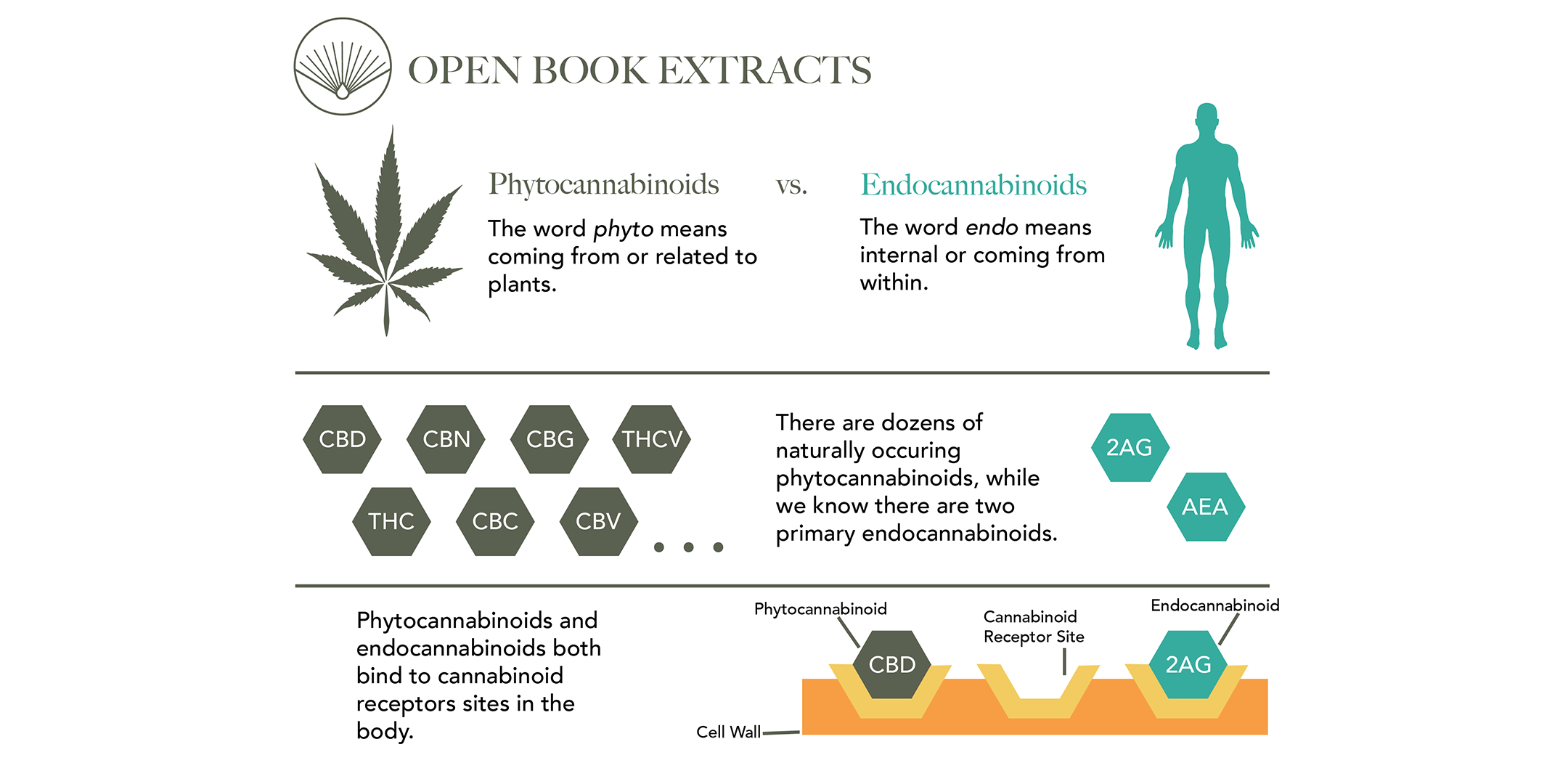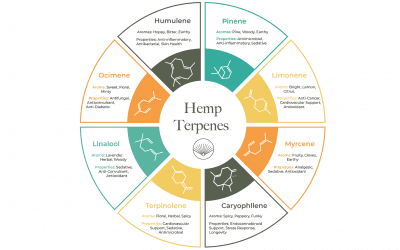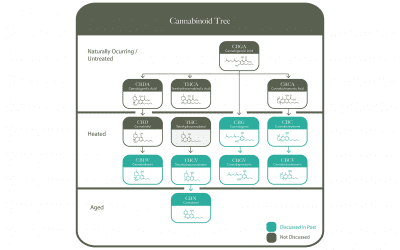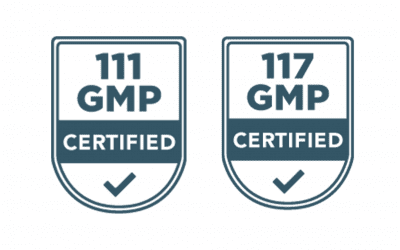
What Are Phytocannabinoids?
Phytocannabinoids are cannabinoids that come from plants. CBD is one of the most well-known and thoroughly-researched phytocannabinoids. However, there are dozens of lesser-known plant cannabinoids that may offer medical benefits, including CBG, CBN, CBC, and more.(1)
Scientists currently believe that phytocannabinoids are able to induce biological effects by mimicking endocannabinoids. For reference, endocannabinoids are chemical messengers that your body naturally produces. These endogenous cannabinoids play an important role in the endocannabinoid system (ECS) and help regulate nervous function, immune function, and organ function.(2)
Some phytocannabinoids are extremely similar to specific endocannabinoids. This allows phytocannabinoids to bind to biological receptors, basically in the same way that endocannabinoids would.(3) So while phytocannabinoids and endocannabinoids have different sources, they are able to elicit remarkably similar effects.
Studies have suggested that endocannabinoid deficiency may cause chronic stress,(4) anxiety,(5) migraines, irritable bowel syndrome, and other conditions.(6) Because of this, doctors have recently started making efforts to upregulate the endocannabinoid system by supplementing with phytocannabinoids.(7) Basically, if you’re body does not produce enough endocannabinoids naturally, you can add in some extra from phytocannabinoid rich plants like hemp oil.
Phytocannabinoids Benefits
Hemp is the primary source of phytocannabinoids, however, these powerful molecules do exist beyond hemp oil; chocolate contains phytocannabinoids, as does echinacea, a flowering plant commonly used in herbal medicine. Different types of plants will have different types of phytocannabinoids. For example, hemp naturally has lots of CBD, whereas echinacea has N-alkylamide.(8)
These plants, and their constituent phytocannabinoids, have been used as medicine for millenia.(9) Today, however, we are entering a new era of phytocannabinoid understanding as we can isolate and research individual phytocannabinoids. As science progresses, we will likely spend much less time talking about what cannabinoids are, and much more time talking about the comparative phytocannabinoids benefits of each.
References
1. Mechoulam, Raphael. “Plant cannabinoids: a neglected pharmacological treasure trove.” British journal of pharmacology 146, no. 7 (2005): 913-5. Web.
2. Silver, Robert J. “The Endocannabinoid System of Animals.” Animals: an open access journal from MDPI 9, no. 9 (2019): 686. Web.
3. Thomas A, Stevenson LA, Wease KN, et al. “Evidence that the plant cannabinoid Delta9-tetrahydrocannabivarin is a cannabinoid CB1 and CB2 receptor antagonist.” Br J Pharmacol.146, no. 7 (2005): 917‐926. Web.
4. Wang W, Sun DL, Pan B, Roberts CJ, Sun XL, et al. “Deficiency in endocannabinoid signaling in the nucleus accumbens induced by chronic unpredictable stress.” Neuropsychopharmacology 35. (2010): 2249–2261. Web
5. Larrieu T, Madore C, Joffre C, Laye S, “Nutritional n-3 polyunsaturated fatty acids deficiency alters cannabinoid receptor signaling pathway in the brain and associated anxiety-like behavior in mice.” Journal of Physiology and Biochemistry 68. (2012): 671–681. Web.
6. Russo EB “Clinical endocannabinoid deficiency (CECD): can this concept explain therapeutic benefits of cannabis in migraine, fibromyalgia, irritable bowel syndrome and other treatment-resistant conditions?” Neuro Endocrinol Lett 25. (2004): 31–39. Web.
7. McPartland, John M et al. “Care and feeding of the endocannabinoid system: a systematic review of potential clinical interventions that upregulate the endocannabinoid system.” PloS one 9, no. 3 (2014). Web.
8. Gertsch, Jürg et al. “Phytocannabinoids beyond the Cannabis plant – do they exist?.” British journal of pharmacology 160, no. 3 (2010): 523-9. Web.
9. Bennett C. Early/ancient history. In: Holland J, editor. The Pot Book: A Complete Guide to Cannabis. Rochester, Vermont: Park Street Press; 2010.

What Are Phytocannabinoids?
Phytocannabinoids are cannabinoids that come from plants. CBD is one of the most well-known and thoroughly-researched phytocannabinoids. However, there are dozens of lesser-known plant cannabinoids that may offer medical benefits, including CBG, CBN, CBC, and more.(1)
Scientists currently believe that phytocannabinoids are able to induce biological effects by mimicking endocannabinoids. For reference, endocannabinoids are chemical messengers that your body naturally produces. These endogenous cannabinoids play an important role in the endocannabinoid system (ECS) and help regulate nervous function, immune function, and organ function.(2)
Some phytocannabinoids are extremely similar to specific endocannabinoids. This allows phytocannabinoids to bind to biological receptors, basically in the same way that endocannabinoids would.(3) So while phytocannabinoids and endocannabinoids have different sources, they are able to elicit remarkably similar effects.
Studies have suggested that endocannabinoid deficiency may cause chronic stress,(4) anxiety,(5) migraines, irritable bowel syndrome, and other conditions.(6) Because of this, doctors have recently started making efforts to upregulate the endocannabinoid system by supplementing with phytocannabinoids.(7) Basically, if you’re body does not produce enough endocannabinoids naturally, you can add in some extra from phytocannabinoid rich plants like hemp oil.
Hemp is the primary source of phytocannabinoids, however, these powerful molecules do exist beyond hemp oil; chocolate contains phytocannabinoids, as does echinacea, a flowering plant commonly used in herbal medicine. Different types of plants will have different types of phytocannabinoids. For example, hemp naturally has lots of CBD, whereas echinacea has N-alkylamide.(8)
These plants, and their constituent phytocannabinoids, have been used as medicine for millenia.(9) Today, however, we are entering a new era of phytocannabinoid understanding as we can isolate and research individual phytocannabinoids. As science progresses, we will likely spend much less time talking about what cannabinoids are, and much more time talking about the comparative phytocannabinoids benefits of each.
References
1. Mechoulam, Raphael. “Plant cannabinoids: a neglected pharmacological treasure trove.” British journal of pharmacology 146, no. 7 (2005): 913-5. Web.
2. Silver, Robert J. “The Endocannabinoid System of Animals.” Animals: an open access journal from MDPI 9, no. 9 (2019): 686. Web.
3. Thomas A, Stevenson LA, Wease KN, et al. “Evidence that the plant cannabinoid Delta9-tetrahydrocannabivarin is a cannabinoid CB1 and CB2 receptor antagonist.” Br J Pharmacol.146, no. 7 (2005): 917‐926. Web.
4. Wang W, Sun DL, Pan B, Roberts CJ, Sun XL, et al. “Deficiency in endocannabinoid signaling in the nucleus accumbens induced by chronic unpredictable stress.” Neuropsychopharmacology 35. (2010): 2249–2261. Web
5. Larrieu T, Madore C, Joffre C, Laye S, “Nutritional n-3 polyunsaturated fatty acids deficiency alters cannabinoid receptor signaling pathway in the brain and associated anxiety-like behavior in mice.” Journal of Physiology and Biochemistry 68. (2012): 671–681. Web.
6. Russo EB “Clinical endocannabinoid deficiency (CECD): can this concept explain therapeutic benefits of cannabis in migraine, fibromyalgia, irritable bowel syndrome and other treatment-resistant conditions?” Neuro Endocrinol Lett 25. (2004): 31–39. Web.
7. McPartland, John M et al. “Care and feeding of the endocannabinoid system: a systematic review of potential clinical interventions that upregulate the endocannabinoid system.” PloS one 9, no. 3 (2014). Web.
8. Gertsch, Jürg et al. “Phytocannabinoids beyond the Cannabis plant – do they exist?.” British journal of pharmacology 160, no. 3 (2010): 523-9. Web.
9. Bennett C. Early/ancient history. In: Holland J, editor. The Pot Book: A Complete Guide to Cannabis. Rochester, Vermont: Park Street Press; 2010.




